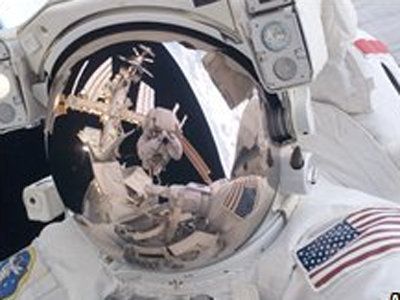
I paged through the NASA report on the last moments of the Columbia crew's lives this weekend. The main report, published way back in August 2003, focused on what went wrong with the mission (and how it could be prevented). Basically, some insulation fell off and poked a hole in the spacecraft. This report focused on the crew's experience and what might have protected them better. In the end, you could say it was moot because they would have died anyway, but there were some specific points that might not be moot some "next time." Specifically, the crew weren't ready to and didn't close their space suits, and they weren't properly restrained -- so that, at the end, their upper bodies probably sustained a lot of damage as the space craft shook and tumbled around wildly. That's a delicate way to say it.
This all puts my training in new perspective! This coming week I'll be spending three days in Houston, and I'm curious what reverberations from the report I'll be hearing. Perhaps this was already common knowledge, but it always helps to see it laid out in a 400-page report.
I've often joked that half our lessons in Star City end as follows: "If all else fails, jump into your space suit and close the helmet!" The problems are two-fold. First of all, it takes a fair amount of time and effort to get suited up -- which is why protocol requires that you already be wearing the space suit at perilous times -- basically, leaving or returning to earth, docking maneuvers and any other time at which you aren't simply in orbit. But even with the space suit on, it takes a bit of time to get the gloves snapped on properly and the helmet closed.
Why not just work with the space suit firmly shut? That's a reasonable question and one that will probably be asked again. For starters, it's uncomfortable. The gloves are awkward, the helmet restricts your vision, and when you're inside a pressurized suit it's hard to do much that's useful. But there's another reason: When the suit is pressurized, it runs off pure oxygen, which you breathe. You exhale carbon dioxide, but the mixture that is slowly released into the space capsule is very high-oxygen, which raises the danger of a fire.
Balancing all these considerations -- pressure, oxygen content, crew comfort and capabilities -- is the challenge. The NASA study suggests that there should be some way for the suits to close and pressurize automatically. The crew seem to have lost consciousness before they even had a chance to close their helmets. This was probably a blessing for them in this case, where they probably suffered less than they might. (And it was definitely a comfort to their families.) But in another case where the craft itself did not disintegrate, an automatic closure could help a crew survive a depressurization.
It will be interesting to see what happens next. At Richard Garriott's launch, I happened to walk in on a talk being given by MIT's Dava Newman, an expert in space suit design who is working on something closer to a wet suit than to the current space suits, which seem more like sausage balloons. I just pinged her, and she replied: "[My] BioSuit has its advantages, the greatest being comfort and flexibility, which come from the Mechanical Counterpressure (MCP) design, in contrast to a gas-filled suit. But they aren't flight-ready yet. My design addresses the issues of allowing maximum mobility/flexibility and providing (relatively) high-pressure (1/3 atm. or 30 kPa) through MCP, or directly applying the pressure to the skin, or body. More research and development is necessary for this concept, but it holds promise for a flexible, emergency pressure suit system." There's also a tension between suppleness and reliable impermeability.
But for now, the biggest issue is simply that the suit is unpleasant and awkward to wear, yet in many cases it can be a lifesaver only if you are already wearing it. In my training, the instructors are still relatively gentle about how long it takes me to get suited up, but I suspect that over time I'll be expected to get quicker.
In the meantime, perhaps, there will be a little more pressure for some innovation -- whether in fundamental design or in some automatic closing mechanisms. In general, the mantra in space travel seems to be "stick with what works, even if it's 40 years old." But this is something that now clearly does not work. How will the system respond?
Context
It's worth noting that the main studies for both the Challenger and the Columbia 17 years later focused on the NASA decision-making culture as the ultimate culprit. Questions went unanswered, concerns were squelched, and so on. In the end, it's as subtle as tone of voice. Try reading this sentence aloud: "So, we've have had a productive meeting. Anyone have anything else to ask?" In one tone of voice, it says, "Okay, let's see what we can learn here. There must be something more...." It's a genuine solicitation for expressions of doubt.
In another it says, "Done. We're finished. Please don't raise anything else." It's basically a threat.
At this point, I don't know enough about the Russian space system to judge how they would ask this question. I'll be listening.